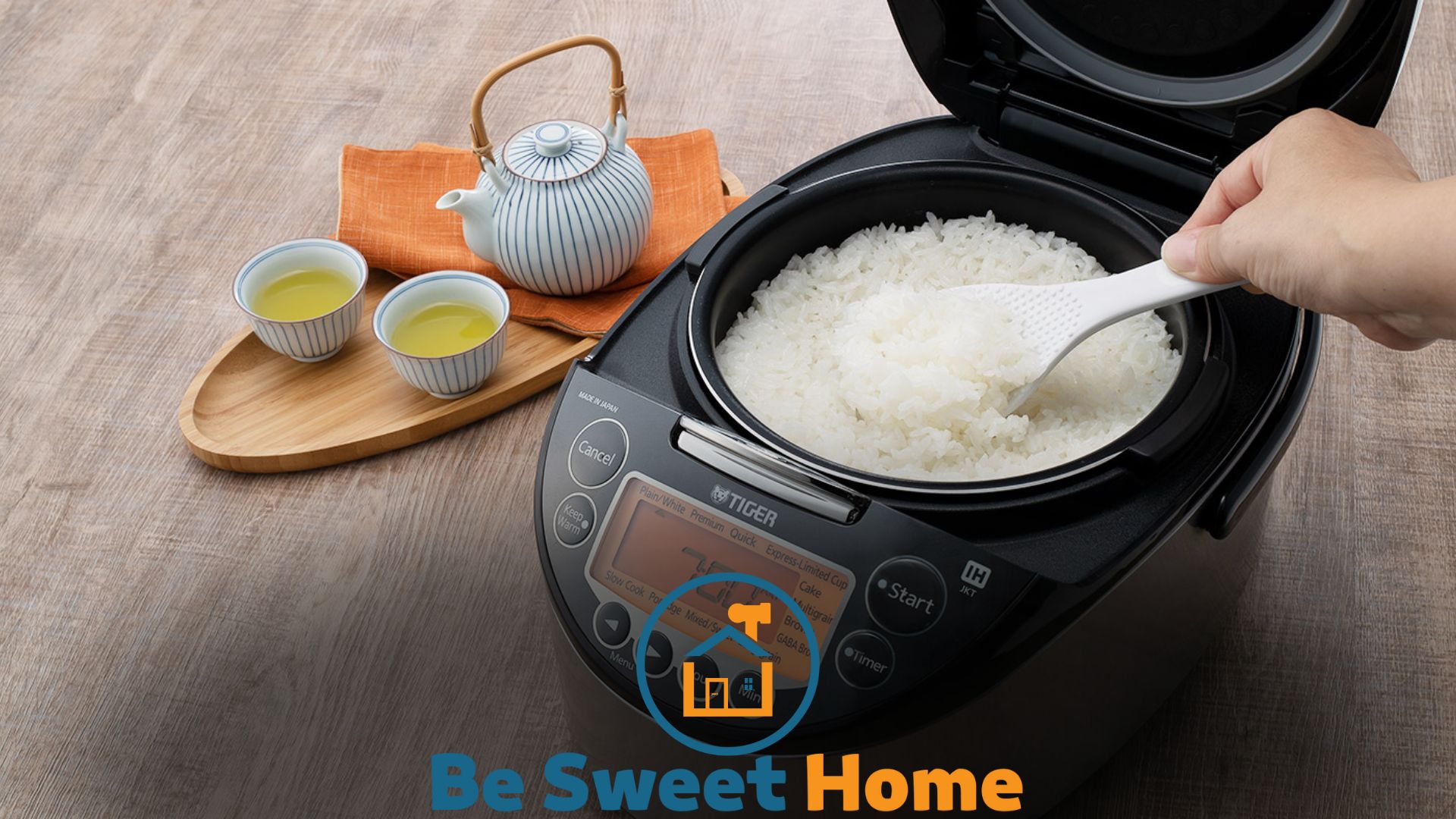

Cooking rice in a rice cooker is simple: rinse the rice, add water, and press the cook button. It’s an easy, hands-off way to make perfect rice every time.
Cooking rice in a rice cooker is a great way to achieve fluffy, perfectly cooked rice without constant monitoring. Whether you’re a beginner in the kitchen or a seasoned cook, using a rice cooker takes the guesswork out of achieving consistent results.
You can enjoy delicious, perfectly cooked rice with minimal effort by following a few easy steps.
We’ll outline the simple cooking process in a rice cooker and provide tips for getting the best results. Whether you’re making white rice, brown rice, or even flavored rice, using a rice cooker can streamline the cooking process and produce excellent results.
Keep reading to learn how to make the perfect rice in a rice cooker every time.
Choosing the Right Rice
Rice is a staple ingredient in households worldwide, and for good reason – it’s versatile, affordable, and an excellent energy source. Cooking rice in a rice cooker is a convenient and foolproof way to achieve perfect, fluffy rice.
However, to achieve the best results, selecting the right type of rice for your rice cooker is important. Different rice varieties can yield different textures and flavors, so choosing the appropriate type is crucial for successful rice cooker cooking.
Different Types of Rice for the Rice Cooker
When it comes to cooking rice in a rice cooker, not all types of rice are created equal. Here are some popular varieties of rice that are well-suited for cooking in a rice cooker:
- White Rice: This is the most common type of rice used for cooking in a rice cooker. It produces fluffy, tender grains perfect for accompanying various dishes.
- Brown Rice: Brown rice takes longer to cook than white rice and requires slightly more water, but it is a healthier, whole-grain option that can be easily cooked in a rice cooker.
- Basmati Rice: Known for its fragrant aroma and long, slender grains, it is a popular choice for Indian and Middle Eastern cuisines and works wonderfully in a rice cooker.
- Short Grain Rice: This type of rice is ideal for making sushi and other Asian dishes. It has a sticky texture that holds together well, making it perfect for rice cooker preparations.
Understanding the Rice-to-Water Ratio
Cooking rice in a rice cooker may seem straightforward, but achieving that perfect fluffy texture requires getting the rice-to-water ratio right. To achieve consistent and delicious results, understanding the importance of water measurement is essential.
Importance of Water Measurement
When cooking rice in a rice cooker, the water measurement is crucial in determining the final texture and consistency of the rice. Adding too much water can produce mushy or sticky rice, while too little can lead to undercooked, dry grains.
Proper water measurement ensures the rice grains are evenly cooked, producing a perfectly fluffy texture with each batch.
Ensuring the Correct Rice to Water Ratio
Calculating the rice-to-water ratio is a simple yet essential step for cooking rice in a rice cooker. The ratio typically varies depending on the type of rice being used. Here’s a general guideline to follow:
| Rice Type | Water Ratio |
|---|---|
| White rice | 1:1.5 (1 cup of rice to 1.5 cups of water) |
| Brown rice | 1:2 (1 cup of rice to 2 cups of water) |
| Basmati or Jasmine rice | 1:1.25 (1 cup of rice to 1.25 cups of water) |
It’s important to note that these ratios are general guidelines, and the specific requirements may vary slightly based on individual rice cooker models and personal preferences.
Adhering to the appropriate rice-to-water ratio can consistently achieve perfectly cooked rice with a delightful texture and flavor.
Using the Rice Cooker
If you’re like me, you love the convenience of a rice cooker. It’s a straightforward and hassle-free approach to always achieving perfectly cooked rice. With proper instructions, you can master the art of cooking rice in a rice cooker without any stress or complications.
Setting Up the Rice Cooker
First, ensure your rice cooker is placed on a flat, stable surface. Then, remove the inner cooking pot from the rice cooker and rinse it with water to remove any dust or debris. Once cleaned, insert the cooking pot back into the rice cooker.
After setting up the rice cooker, you can measure the desired amount of rice using a measuring cup. Then, pour the rice into the cooking pot. It’s important to use the correct water ratio for rice, usually 1:1 or 1:2, depending on the type of rice.
Ensure Proper Water Measurements
Take note of the water levels marked on the inner wall of the cooking pot. These indicators will guide you in adding the appropriate amount of water for the specific quantity of rice.
Once the water is added, use the provided paddle or a spoon to level the surface of the rice and water to ensure even cooking.
Starting the Cooking Process
After adding water, securely position the lid onto the rice cooker. Plug in the device, and then turn it on. Most rice cookers have indicator lights that will switch to “cook” mode once the rice cooking process begins.
Depending on the model of your rice cooker, it may automatically switch to “keep warm” mode once the cooking cycle is complete.
When the rice is ready, allow it to sit in the “keep warm” mode for a few minutes before serving. This will allow the rice to settle, resulting in perfectly cooked, fluffy rice.
Adding the Rice and Water
Cooking rice in a rice cooker is convenient and easy to consistently achieve perfectly cooked rice. One of the crucial steps in using a rice cooker is adding the right proportions of rice and water.
Achieving the ideal rice-to-water ratio ensures your rice turns out fluffy and delicious. Let’s dive into the correct measurements for perfect rice and how to ensure optimal results with every batch.
Correct Measurements for Perfect Rice
When preparing rice in a rice cooker, it’s essential to use the correct measurements to achieve the ideal texture and consistency. Determining the right rice-to-water ratio is crucial for perfectly cooked rice.
Here’s a guideline to help you achieve the perfect balance.
| Rice Variety | Water Ratio |
|---|---|
| White rice (long-grain) | 1 1/2 to 1 3/4 cups of water per cup of rice |
| Brown rice (long-grain) | 2 to 2 1/2 cups of water per cup of rice |
| Basmati or Jasmine rice | 1 1/2 cups of water per cup of rice |
Ensuring Optimal Results
To ensure the best outcome when cooking rice in a rice cooker, follow these tips to guarantee ideal texture and flavor:
- Always measure the rice and water accurately using a designated rice cup and adjust the ratio based on the rice variety used.
- Before adding the rice and water to the cooker, rinse the rice thoroughly under cold water to remove excess starch, which can cause the rice to become sticky.
- After adding the rice and water to the cooker, gently stir the mixture to ensure an even distribution of rice and water. This helps in achieving uniform cooking.
- For enhanced flavor, consider substituting some of the water with broth or adding seasoning to the water before cooking.
Tips for Optimal Results
When cooking rice in a rice cooker, following some key tips can ensure you get perfectly cooked, fluffy rice every time. Whether you are a beginner or a seasoned chef, these simple yet effective tips will help you achieve optimal results with your rice cooker.
Avoiding Common Mistakes
One of the most common mistakes when cooking rice in a rice cooker is not rinsing the rice beforehand. Rinsing the rice helps remove excess starch, which can lead to sticky and clumpy rice.
Another common mistake is using the wrong ratio of water to rice. Following the manufacturer’s instructions for the correct water-to-rice ratio is important to achieve the best results.
Additionally, some people lift the cooker lid during the cooking process to check the progress, disrupting the cooking cycle and leading to unevenly cooked rice. It’s essential to resist the temptation to lift the lid and allow the rice to cook undisturbed.
Ensuring Even Cooking
For optimal results, it’s crucial to distribute the rice evenly in the cooking pot of the rice cooker. Distribute the rice in an even layer at the bottom of the pot to ensure uniform cooking.
In addition, adding the water evenly over the rice will help prevent pockets of undercooked or overcooked grains.
Another way to ensure even cooking is to fluff the cooked rice with a fork or paddle immediately after it’s done. Fluffing the rice helps release excess moisture and prevents it from becoming too compact, resulting in a light and fluffy texture.
Enhancing the Flavor With Additional Ingredients
While a rice cooker is a fantastic tool for perfectly cooked rice, it also offers the opportunity to elevate the flavor profile of your rice dishes by incorporating additional ingredients directly into the cooking process.
Utilizing the Rice Cooker’s Features
By utilizing the rice cooker’s steam feature, you can infuse your rice with the flavors of various herbs, spices, or aromatics. Place these ingredients in the steam basket or on the rice before starting the cooking cycle.
This method allows the steam to carry the flavor of the additional ingredients into the rice, resulting in a more nuanced and aromatic dish.
Adding Ingredients to the Rice Directly
Directly adding ingredients to the rice cooker can also enhance the flavor of your rice. Whether adding broth instead of water, mixing in diced vegetables, or tossing in a handful of herbs, the rice cooker provides a convenient platform for these additions to infuse the rice with extra flavor while it cooks.
Creating Flavor-infused Oils
Infusing oils with additional flavors and using these oils to cook the rice can also take the flavor to the next level. This can be done by adding herbs, garlic, or spices to hot oil in the rice cooker before adding the rice and water.
The heat of the oil will release the aromatic compounds in the added ingredients, infusing the oil and, subsequently, the rice with a delightful flavor.
Adding Toppings Post-cooking
Consider adding toppings and condiments after the rice has finished cooking. A sprinkle of toasted sesame seeds, a drizzle of soy sauce, or a dollop of compound butter can provide a final touch that enhances the dish’s overall flavor.
Serving and Storing
The previous sections covered the steps to cook perfect rice in a rice cooker. Now, let’s explore how to serve and store the cooked rice to ensure it maintains its deliciousness and texture.
Ensuring Fluffiness and Proper Consistency
When serving the cooked rice, it’s essential to maintain its fluffiness and proper consistency. Here are some tips:
- Use a fluffed rice paddle or a fork to gently stir the rice before serving.
- Store the cooked rice in a covered container to keep it warm and maintain its fluffiness.
Proper Storage
Storing the cooked rice properly is crucial for maintaining its quality. Follow these guidelines:
- Wait for the rice to cool to room temperature before storing it in an airtight container.
- Refrigerate any leftover rice within two hours of cooking to prevent bacterial growth.
Storing Cooked Rice
After cooking the perfect batch of rice in your rice cooker, you may find yourself with leftovers. Properly storing cooked rice is essential for maintaining its texture and flavor. Here’s how to store and reheat your rice for optimal enjoyment.
Reheating and Repurposing Leftover Rice
When reheating leftover rice, it’s important to add a splash of
water before microwaving to prevent it from drying out.
Place the rice in a microwave-safe dish, add a bit of water, cover it with a
damp paper towel, and heat in short intervals until it’s warmed
through.
Conclusion
Mastering rice cooking in a rice cooker can elevate your culinary skills. With the right techniques and ingredients, you can always achieve perfectly fluffy and flavorful rice. Embracing this convenient and hassle-free method will simplify your cooking routine and add a delicious meal staple.
So, why not give it a try and elevate your rice game?







